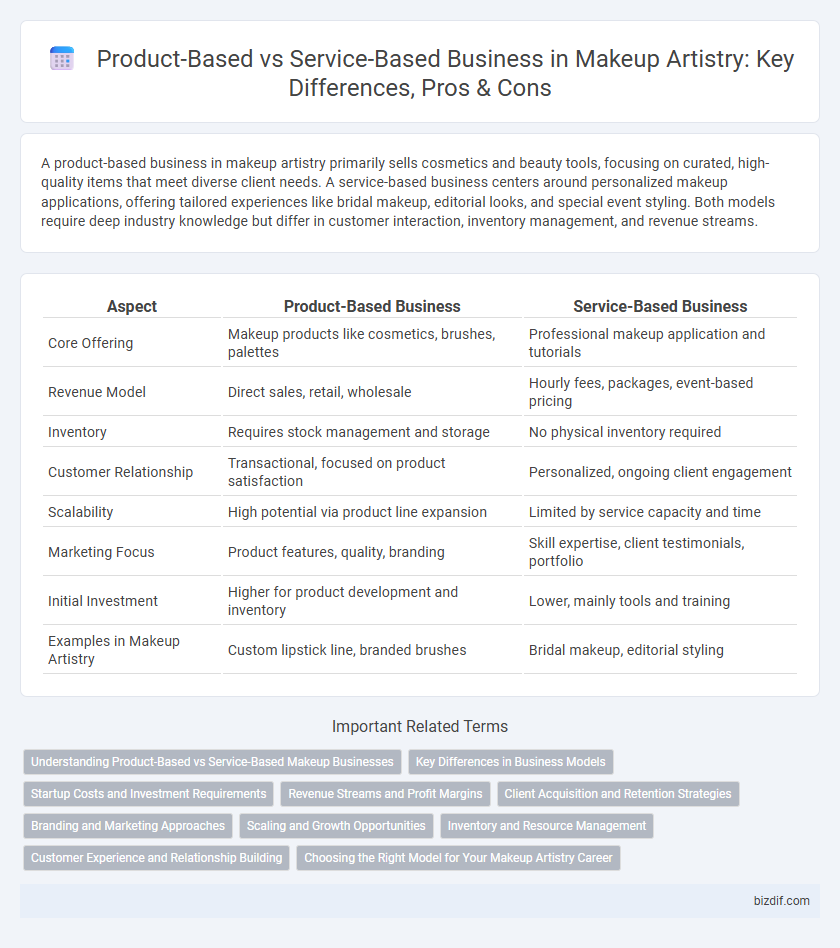A product-based business in makeup artistry primarily sells cosmetics and beauty tools, focusing on curated, high-quality items that meet diverse client needs. A service-based business centers around personalized makeup applications, offering tailored experiences like bridal makeup, editorial looks, and special event styling. Both models require deep industry knowledge but differ in customer interaction, inventory management, and revenue streams.
Table of Comparison
| Aspect | Product-Based Business | Service-Based Business |
|---|---|---|
| Core Offering | Makeup products like cosmetics, brushes, palettes | Professional makeup application and tutorials |
| Revenue Model | Direct sales, retail, wholesale | Hourly fees, packages, event-based pricing |
| Inventory | Requires stock management and storage | No physical inventory required |
| Customer Relationship | Transactional, focused on product satisfaction | Personalized, ongoing client engagement |
| Scalability | High potential via product line expansion | Limited by service capacity and time |
| Marketing Focus | Product features, quality, branding | Skill expertise, client testimonials, portfolio |
| Initial Investment | Higher for product development and inventory | Lower, mainly tools and training |
| Examples in Makeup Artistry | Custom lipstick line, branded brushes | Bridal makeup, editorial styling |
Understanding Product-Based vs Service-Based Makeup Businesses
Product-based makeup businesses focus on selling tangible cosmetics like foundations, eyeshadows, and brushes directly to consumers, leveraging brand reputation and product quality for customer loyalty. Service-based makeup businesses offer personalized applications, such as bridal makeup or special event styling, emphasizing skill, customer experience, and customized results. Understanding the differences helps makeup artists choose between investing in inventory and retail channels or building client relationships through hands-on services and appointments.
Key Differences in Business Models
Product-based makeup artistry businesses generate revenue by selling physical items such as cosmetics, brushes, and skincare products, emphasizing inventory management and supply chain optimization. Service-based businesses focus on providing makeup application services for events, requiring skilled labor and scheduling efficiency. Key differences include the need for inventory investment in product-based models versus the reliance on client relationships and appointment bookings in service-based models.
Startup Costs and Investment Requirements
Product-based makeup artistry businesses typically require higher startup costs due to inventory purchase, packaging, and shipping expenses, alongside investments in branding and e-commerce platforms. Service-based makeup businesses demand lower initial investment, focusing primarily on quality tools, professional training, and marketing to build a client base. Understanding these financial commitments is crucial for makeup artists when choosing between developing product lines or offering personalized makeup services.
Revenue Streams and Profit Margins
Product-based makeup artistry businesses generate revenue through the sale of cosmetics, tools, and branded merchandise, often benefiting from higher profit margins due to bulk production and repeat purchases. Service-based makeup businesses rely on fees charged for personalized makeup application, bridal services, and makeup lessons, with revenue tied to appointment frequency and client retention. While product sales offer scalable income and passive revenue streams, service-based models typically provide higher per-transaction profits but require continuous client engagement to sustain cash flow.
Client Acquisition and Retention Strategies
Product-based makeup artistry businesses leverage targeted social media advertising and influencer partnerships to acquire clients by showcasing tangible results and exclusive product lines. Service-based makeup artists prioritize personalized consultations and exceptional on-site experiences to build trust and retain clients through tailored beauty solutions and consistent follow-ups. Both models benefit from loyalty programs and client feedback integration, enhancing customer satisfaction and long-term engagement.
Branding and Marketing Approaches
In makeup artistry, product-based businesses focus on showcasing the quality and uniqueness of cosmetics through captivating packaging and influencer endorsements to build strong brand visibility. Service-based businesses emphasize personalized client experiences and portfolio development, leveraging social media to highlight transformations and customer testimonials for effective marketing. Strategic branding in both models involves targeting specific demographics and leveraging online platforms to create loyal customer communities.
Scaling and Growth Opportunities
Product-based makeup artistry businesses offer scalable growth by allowing mass production and distribution of cosmetic lines, enabling wider market reach and consistent revenue streams. Service-based makeup artistry businesses depend heavily on individual client appointments, which can limit scalability but allow for personalized experiences and premium pricing. Combining both models can optimize growth opportunities by expanding brand presence while maintaining client relationships.
Inventory and Resource Management
Product-based makeup artistry businesses require efficient inventory management to track cosmetics, tools, and supplies, ensuring consistent stock levels and timely replenishment. Service-based makeup artistry relies heavily on well-maintained resources, such as brushes and portable equipment, emphasizing scheduling and client management over physical inventory. Effective resource allocation in both models enhances operational efficiency, reduces waste, and supports client satisfaction.
Customer Experience and Relationship Building
In makeup artistry, a product-based business offers tangible items like cosmetics and tools, enabling clients to recreate looks independently while fostering brand loyalty through quality and innovation. Service-based businesses deliver personalized makeup applications and consultations, creating deep emotional connections and trust through direct interaction and tailored experiences. Prioritizing customer experience in both models enhances relationship building, but service-based approaches typically cultivate longer-term client engagement through customized care.
Choosing the Right Model for Your Makeup Artistry Career
Service-based makeup artistry businesses offer personalized client experiences and flexibility in customizing looks, essential for building long-term relationships. Product-based businesses focus on selling makeup tools and cosmetics, providing scalable passive income but requiring inventory management and strong marketing. Choosing the right model depends on your skills, business goals, and whether you prefer hands-on client interaction or product sales for growth.
Product-based business vs Service-based business Infographic

 bizdif.com
bizdif.com